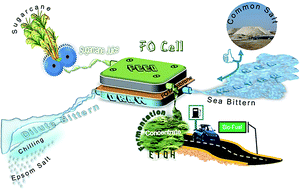Four-fold concentration of sucrose in sugarcane juice through energy efficient forward osmosis using sea bittern as draw solution†
Abstract
Clarified sugarcane juice (osmotic coefficient, φ, ∼1.01) was efficiently dewatered through the spontaneous process of Forward Osmosis (FO) employing sea bittern as draw solution. Sea bittern is the mother liquor that remains after recovery of common salt from seawater. It is either discarded to sea or evaporated to higher densities in solar salt pans for recovery of other marine chemicals such as bromine, Epsom salt, potash and magnesium chloride. Compared to seawater (φ = 0.905) which has limited potential as draw solution, the φ values of the sea bittern samples were in the range of 1.41 to 3.24, providing thereby a high osmotic drive. A polyamide thin film composite membrane was used in the study. With 1 bar applied pressure, room temperature operation, and 1 : 8 volume ratio of sugar cane juice to bittern (φ = 2.26; concentrations of main constituents (% w/v): Na+ = 2.83, K+ = 2.03, Mg2+ = 7.42, Cl− = 23.48, SO42− = 8.42), sucrose concentration in the juice was enhanced from 10.5% (w/v) to 40.6% (w/v) over 4 h, with average flux of 13 L m−2 h−1. Sucrose loss was <3%. Energy computations indicated a saving of 69 kg of bagasse per m3 of raw juice, assuming all process energy (steam/electricity) is derived from bagasse. Epsom salt of high purity was recovered from the spent draw solution upon chilling.


 Please wait while we load your content...
Please wait while we load your content...